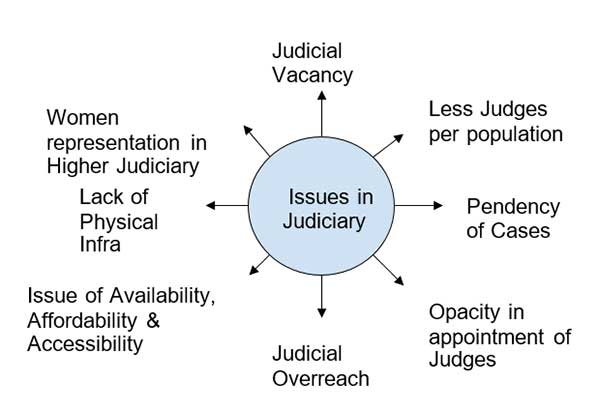Relevance: GS-2: Separation of powers between various organs dispute redressal mechanisms and institutions; Structure, organisation and functioning of the Judiciary
Key Phrases: Chief Justice of India, Article 142, 142 (4), 218, Separation of Power, Contempt of Court, Prashant Bhushan Case, Brahma Prakash Sharma vs State of U.P. (1953)
Why in News?
- On December 10, 2021 Former Chief Justice of India (CJI) Ranjan Gogoi said “Corruption is as old as society. Corruption has become an acceptable way of life and judges don’t fall from heaven.”
- This brings into focus the issue of corruption in Judiciary
Allegations of Corruption in Judiciary
From academic point of view, Judicial corruption has 3 - dimensions - Political interference, bribery and decline in Judicial values
- Political Interference
- Post retirement appointments without cooling off period raises questions on Judicial independence. E.g. ex-CJI being nominated to Rajya Sabha or an ex-CJI becoming Governor of a state
- Allegations of bribery and/ or Conflict of Interest
- There have been allegations of bribery or conflict of interest or favouritism doing rounds in the print media in the recent past . The allegations involved issues from judgements in favour of a business house , priority in listing of cases to issues leading to an impeachment motion against an ex-CJI.
- Decline in Judicial Values
- Continuous usage of Contempt of Court case to silence criticism
- Prashant Bhushan Case (2020) - as he had mentioned “Judges who have presided in the Supreme Court (SC) in the period of the last six years have a particular role in the destruction of Indian democracy”
- Similar contempt proceedings were initiated by former CJI Rajan Gogoi against SC Judge Markandey Katju for criticism of CJI. This was later revoked after Justice Katju issued unconditional apology
- Continuous usage of Contempt of Court case to silence criticism
Need of removing Corruption from Judiciary
- For preventing scandalising of entire institution of SC
- Wilmot, C.J. in R. vs Almon (1765) had remarked that corruption in Judiciary demands immediate redress. Judicial corruption is the most fatal and most dangerous obstruction of justice. And this immediate redress is is required not for the sake of the Judges, as private individuals, but because they are the channels by which King’s Justice is conveyed to the people
- For establishing Rule of Law
- For ensuring Judiciary remains the protector of Constitutional Morality
- To ensure Separation of Power (Article 50)
- Article 142 empowers SC to render complete justice. Corruption in Judiciary is an impediment to justice
- To check corruption in Executive and Legislature, Judiciary must take care of such allegations first
Challenges in removing corruption
- Contempt of Court has been used readily to silence constructive criticism
- Nepotism and Favouritism in Judicial appointment have provided ground for corruption in judiciary to flourish
- Judicial Accountability is lacking
- Lack of public trials
- Ineffective means to impeach and incompetent and a morally
compromised Judge of High Court (HC) and SC
- Despite Article 124(4) [for SC] and Article 218 [for HC], no Judge from higher Judiciary has been ever removed
- As these are cumbersome and lengthy in procedure
- Since independence, only few judges have ever faced impeachment for misappropriating public funds
- Lack of institutional mechanism to analyse the performance of judges of SC and HC and hold them to account.
- Absolute Power corrupts absolutely (Lord Acton has famously said ‘Power corrupts but absolute power corrupts absolutely’) - Judges have unprecedented and unbridled power and as per Transparency International Indian Judicial system exemplifies opacity
- Higher corruption in Lower Judiciary which eventually seeps into higher judiciary due to promotion
Measures to be taken to remove Judicial corruption
- Legal Measure
- Judicial Standards and Accountability Bill, 2010 could be revived
- Standards of conduct of judges to be enforced
- Requires judges to provide information regarding assets and liabilities of themselves and their family members
- Contempt of Court to be invoked in rare cases
- The Constitution Bench of the Supreme Court in Brahma Prakash Sharma vs State of U.P. (1953) had taken cognisance that object of contempt proceedings is not to afford protection to Judges, personally from imputations to which they may be exposed as individuals; it is intended to be a protection to the public whose interests would be very much affected if by the act or conduct of any party, the authority of the court is lowered and the sense of confidence which people have in the administration of justice by it is weakened
- Judicial Standards and Accountability Bill, 2010 could be revived
- Institutional Measure
- Judicial Service Commission as suggested by Law commission in its 121st report
- Policy Measure
- Bangalore Principles of Judicial Conduct identify six core values of the judiciary – Independence, Impartiality, Integrity, Propriety, Equality, Competence and Diligence
- International Measure
- Transparency International’s Report (2007) has factored in
Judicial corruption
- 77% correspondents complained of the corruption in Indian judiciary
- Various countries have ensured Judicial offices to be within the reach of transparent office of Ombudsman
- Transparency International’s Report (2007) has factored in
Judicial corruption
- Technological Measure
- The SC in Swapnil Tripathi v Supreme Court of India (2018) has ruled in favour of opening up the apex court through live-streaming
- Supreme Court Portal For Assistance in Court's Efficiency (SUPACE) is an AI portal aimed at data mining, tracking progress of cases, legal research and other uses to ensure timely delivery of justice by judges
- SUVAS - for vernacular translation of SC judgments to increase transparency
Conclusion
- SC’s motto is Yato Dharmas tato Jayah i.e. Where there is Justice there will be victory, In order to ensure Justice in letter and spirit, Corruption in the judiciary must be eliminated root and branch.
Source: The Hindu
Mains Question:
Q. Indian Judiciary is a bastion of Justice, but Judicial corruption is a reality. Critically analyse and suggest measures for improvement.







